Market Views: HDD Shipments Down 20% in Q1 2016, Hit Multi-Year Low
by Anton Shilov on May 12, 2016 8:00 AM ESTShipments of Client HDDs as a function of all Client Drives Drop
Long gone are the days when shipments of client HDDs by Seagate and Western Digital were around 75 million units per quarter. When PC sales drop to 60 – 66 million of units per quarter, it is simply impossible to sell that many drives. The two leading makers of HDDs supplied 45.7 million of hard disks in Q1 2016, down from 63.4 million from the same quarter last year. While Toshiba’s consumer drives should not be forgotten, it is evident that the increasing amount of new PCs use SSDs these days.
The SSD adoption rate in the notebook market in Q4 2015 was approximately 25~26%, according to TrendForce. In the first quarter that figure could easily go up because Seagate admitted that it did not want to play a part in certain areas of the low capacity notebook market. Moreover, as HDD platforms get more expensive in the coming years, hard drive makers may simply leave low-end bulk storage to SSD makers. In the end, it is relatively easy to build SSDs these days (it is not easy to manufacture NAND flash, of course), but HDD production involves a lot of R&D and state-of-the-art manufacturing facilities. As a result, companies like Seagate or Western Digital may simply lose interest in entry-level hard drives, especially given the fact that soon Western Digital will become a supplier of consumer SSDs as well.
As pointed out in the previous report, Seagate includes shipments of hard disk drives it sells for game consoles into its 2.5” client HDD category, whereas Western Digital includes its drives for consoles into its consumer electronics category. As a result, the picture is somewhat noisy here. Seagate sold 10.6 million 2.5” client HDDs in the first quarter, which is a drop of 37% from the same period a year ago. Since the company deliberately decided not to fight for low-end notebook deals, such a sharp decline is not something unexpected. Meanwhile, Western Digital supplied 13.6 million of its 2.5” client hard drives in Q1 2016, 28% less than in the same quarter last year.
Sales of client 3.5” HDDs by Seagate and Western Digital declined by 22.8% year-over-year, in line with the deterioration in the HDD market. Moreover, actual shipments of desktop hard disks were on the same level for the two leading makers: Seagate supplied 10.8 million units (a 24.5% drop YoY), whereas Western Digital shipped 10.7 million devices (a decrease of 21% YoY). We do not know how many 3.5” client hard drives Toshiba shipped in Q1, but it is safe to say that the market is on the decline in general and it does not make a lot of sense to fight for desktop market share these days.
In its recent conference call with investors and financial analysts, Seagate re-emphasized that it expected sales of its client drives to continue declining, but to keep gaining capacity. Historically, sales of Seagate’s client HDDs accounted for 60% of its revenue, whereas sales of enterprise products accounted for 40% of its revenue. Given the current market trends away from installing HDDs into tablets, 2-in-1 hybrid PCs or ultra-thin notebooks, client HDD revenue will eventually drop to 40% of Seagate’s revenue whereas enterprise hard drives will account for 60% of its revenue, the company revealed. With that said, it is expected that Seagate will focus on higher-capacity drives rather than on inexpensive devices that help to boost unit sales, as the latter is not something that is needed ion a weakening market.
Sales of External HDDs and NAS Fall
Because the number of PCs that cannot house more than one internal storage device is growing, external storage is getting some traction. Seagate and Western digital offer broad lineups of DAS and NAS devices under their own trademarks as well as under G-Technology and LaCie brands. While shipments of branded storage products do not drive huge volumes, this is a rather lucrative business for manufacturers offering higher ASPs.
Sales of branded DAS and NAS devices by Seagate and Western Digital totaled 10.357 million units in the first quarter of 2016, down 7.5% from 11.190 million units in Q1 2015. The two manufacturers sold an equal amount of external storage products: Seagate shipped 5.200 million branded devices (up 2% YoY), whereas Western Digital sold 5.157 million branded products (down 15.3% YoY). Historically, Western Digital outsold its main competitor with its My Cloud and My Passport external HDDs, but in the recent quarters Seagate has begun to catch up whereas sales of WD began to decline.
One thing that should be kept in mind when analyzing branded storage is that no matter how many HDDs are inside a DAS or a NAS, they are all considered as one unit (e.g., a WD My Book, a WD My Book Duo and a fully-populated My Cloud DL4100 are equal from accounting perspective). As a result, while we do see that unit sales of branded external storage by the two large makers have been slowly declining in the recent quarters, we do not know anything about the exact amount of drives inside as well as their storage capacities.
Consumer Electronics Still Consume A Lot of HDDs
The vast majority of consumer electronics (CE) devices nowadays use NAND flash memory. However, applications like set-top-boxes, DVRs, surveillance systems and game consoles remain sizeable consumers of hard drives, which is why makers of HDDs develop platforms specifically tailored for such devices.
Since shipments of Seagate’s CE HDDs do not include drives it supplies for game consoles (they are included in client 2.5” HDD sales), its CE business looks relatively stable and mostly driven by seasonality. In the first quarter of 2016, Seagate sold 5 million of CE HDDs, slightly up from 4.8 million supplied in the same period a year ago.
By contrast, Western Digital recognizes HGST Travelstar HDDs for Sony’s PlayStation 4 as consumer drives, which is why its CE numbers significantly depend on the production of PS4. Since in Q1 console sales and manufacturing are not on the rise, sales of Western Digital’s CE HDDs declined to 7.3 million units, down 15.2% from Q1 2015. The reasons for the drop are unclear - perhaps Sony decided to slow down PS4 production, or perhaps shipments of some other Western Digital products were not strong.
Anyway, due to account policies of the two leading makers of hard drives, it is impossible to compare their CE HDD businesses directly.


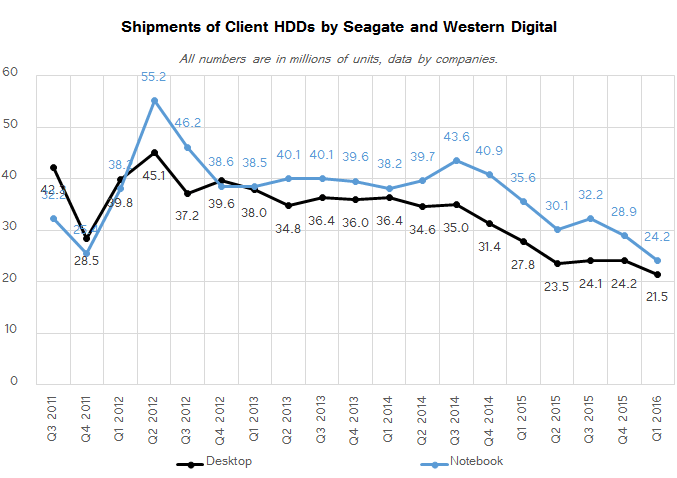
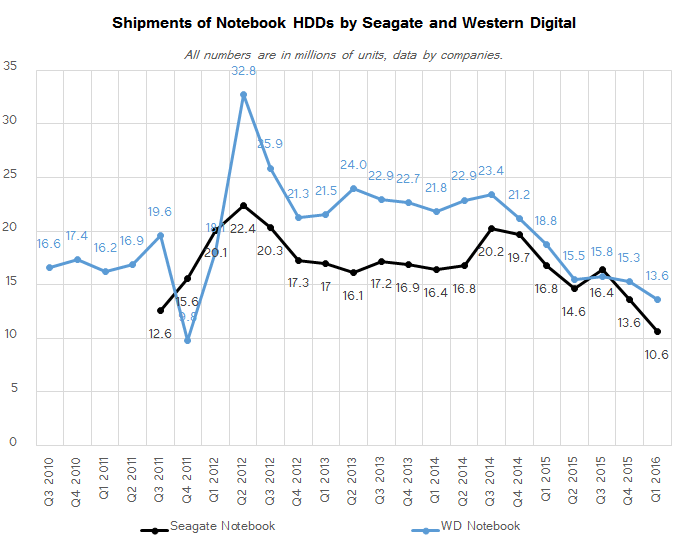
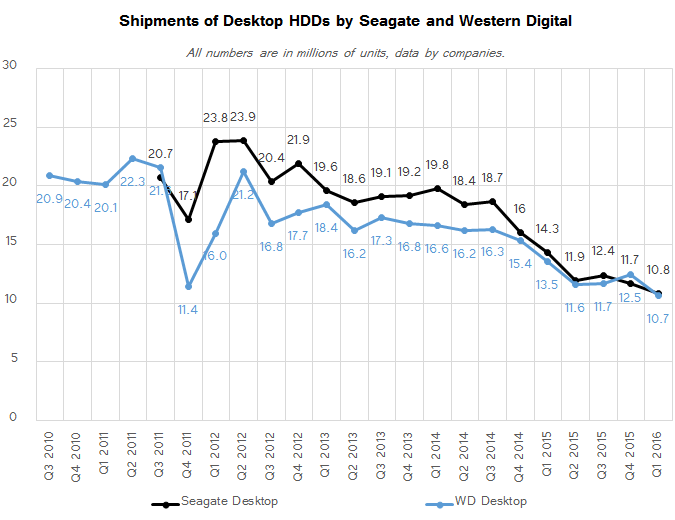
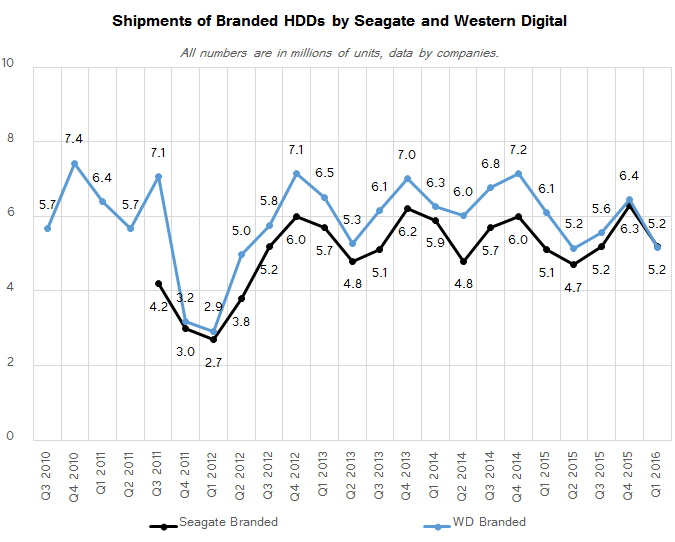
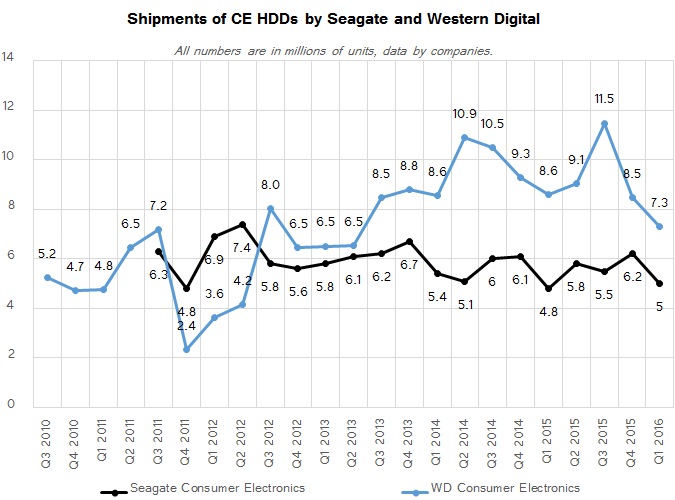








116 Comments
View All Comments
nandnandnand - Thursday, May 12, 2016 - link
Don't trust the cloud! It's meant to shackle and spy on you!Wolfpup - Thursday, July 14, 2016 - link
It's also way too slow, way too unreliable, and way, way, way too limited by bandwidth caps.tamalero - Tuesday, May 17, 2016 - link
Makes you wonder if most companies will just switch to corporate/business storage devices in the end. And leave the SSDs for consumer market.Achaios - Thursday, May 12, 2016 - link
I upgraded my Dec 2013 rig last mont.One of the upgrades, was replacing the two WD Green 2TB drives in Raid 1 I had with two WD Blue 6 TB drives also placed in Raid 1.
This will set me up for the next 5-6 years, so presumably I won't be buying any more HDD's until then.
My rig uses a Samsung 840 EVO 500 GB SSD as an OS/Games drive and a Samsung 750 120GB SSD (upgrade) as an emergency boot drive/virtual memory drive.
I think I am all set until the next major upgrade event. Don't think I will be buying any more storage (SSD or HDD) for the next 5 years or so.
bill.rookard - Thursday, May 12, 2016 - link
Agreed. I just updated my NAS with some 4TB enterprise drives (3x4TB in RAID5) and retired my 5x2TB RAID5 array. Same overall size, but vastly increased reliability and I should be good for a few years.Meanwhile all my new builds are SSD based.
TheinsanegamerN - Thursday, May 12, 2016 - link
SSDs are big enough now that most users dont need HDDs anymore.Even for gamers, the richer ones can afford all SSD storage. My laptop has a 256 and 512GB SSDs in it, and I feel no squeeze for space, just install the games you actually play. And if more space is needed, 2TB SSDs exist now. I doubt many gamers need more than 2TB of games downloaded at any one point.
Which leaves media creation and one of the few that still need HDDs, although that may change. Outside of backup devices, HDDs dont have much of a future in consumer devices.
DanNeely - Thursday, May 12, 2016 - link
Agreed; however the problem is that most consumers don't understand that SSDs will make their laptop much more responsive; and that the lack of spinning rust is the biggest reason why their phone and tablet are so much more responsive. 3/4ths of PCs are still crippled with HDDs and sold to customers who only understand two numbers: Total price, less is always better here. Number of GB, more is always better here. If they don't actually need the disk space, and most don't, they're wrong about the latter; but you can't fight ignorance at the boxmart.Just checking prices for new name brand laptop HDDs on Newegg shows the price margin between 1TB drives and smaller ones has almost completely vanished: 250 GB, $39; 320 GB, $45, 500 GB, $45; 1TB $52; 2 TB, $94. Just based on how far 1 TB laptop drives have dropped in price I'm not surprised that Seagate's discontinuing their smaller capacity drives; WD and Toshiba will probably end up doing the same within a year.
At the same time the cheapest ~960GB SSD on Newegg is still $200, with $50 only getting you 240GB. That's enough of a price/capacity gap to keep the majority of the clueless with legacy storage for at least a few more years.
TheinsanegamerN - Thursday, May 12, 2016 - link
Very true, but the kind of people that dont understand SSDs are probably the same kind of people that want the most GBs because they think it will make the computer faster. Nothing will help them I'm afraid.But then, the cheap junk they usually buy gets the scrap parts anyway, the good lines of HDDs always went into business machines and stuff with a higher margin. That market is falling in love with SSDs very quickly.
FunBunny2 - Thursday, May 12, 2016 - link
-- But then, the cheap junk they usually buy gets the scrap parts anyway, the good lines of HDDs always went into business machines and stuff with a higher margin.and the same thing is happening in the SSD space.
DanNeely - Thursday, May 12, 2016 - link
Technically illiterate customers looking at the only number they think they understand and wanting HDDs was my point. Excluding those willing to pay a little extra for a stylish thin laptop I don't see that changing any time soon because the price per GB difference is still way too large.